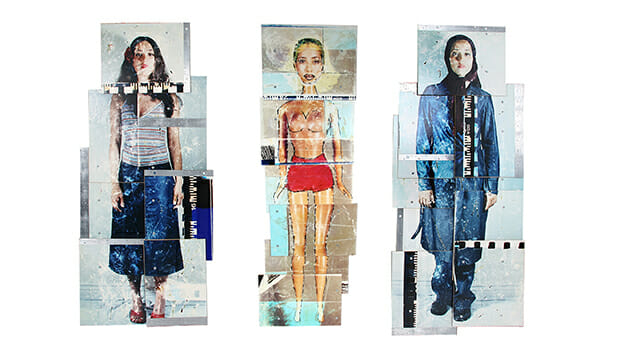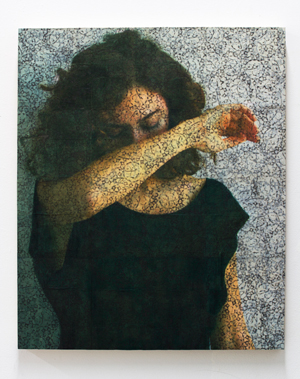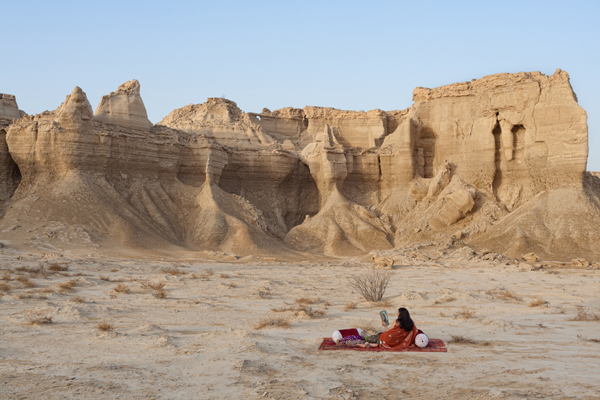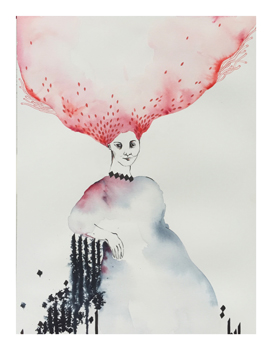Art for Strange Times: THE (UN)DRAPED WOMAN
More Iranian Artists You Can Support Now
Photos courtesy of Advocartsy and the artists Visual Arts Features Roshi Rahnama
“These are strange times, my dear…”
You’ll find this ominous echo in Ahmad Shamlu’s seminal poem, In this Blind Alley, written shortly after the 1979 Iranian Revolution. It’s eerily resonant today in the Unites States of America. As the country is confronted with violations of civil rights, border controls, and inexhaustible political fear mongering, artists have fearlessly continued to create both quietly and explicitly political work, forcing us to cast our eye toward the textures of what it means to be human. In this vein, Arena I Gallery at Santa Monica Art Studios in Santa Monica is showing ART BRIEF III: THE (UN)DRAPED WOMAN until February 18.
The show is presented by Advocartsy, a collaborative visual arts platform and advocacy organization based in California. Established in 2015 by Roshi Rahnama, Advocartsy’s mission is to elevate awareness of and engagement with Iranian contemporary art in Los Angeles. The city is home to the largest global Iranian diasporic population. Fourteen artists of Iranian origin explore representations of women against various social and historical circumstances in the bold show.
Creative engagement is especially important now, in light of the 45th President’s January 27th executive order temporarily banning immigrants and refugees hailing from seven Muslim-majority countries. To welcome and consider global artistic expressions as curator, artist or patron is a political, social, and ethical act. To engage with any group deemed as imminently “bad” and “posing a threat” is a necessary form of protest. It requires an openness to possibility, a refusal to universally employ rhetoric of dismissal over any group. This is why art is one of our greatest hopes against totalitarianism, authoritarianism, and bigotry.
In Ways of Seeing, the late John Berger said “It is seeing which establishes our place in the surrounding world; we explain that world with words, but words can never undo the fact that we are surrounded by it.” Sandra Williams, assistant curator in the Art of the Middle East Department at the Los Angeles County Museum of Art (LACMA), explains that the exhibiting artists “depict women in various states of cover, yet as all their works show, external appearances, whether fully exposed or not, are rarely a gateway to comprehending female identity.” Echoing Berger, Williams asks us to consider how the female form, expressions, and identities is mediated by a series of social, cultural, political, and gendered terms. To see someone is to consider their appearance also as a form of concealment—appearance then not only is a method of revelation, but it can act, and often does act as a method of protection, privacy, and refraction.
“A metaphor for domesticity, docility, and the veiling of the feminine body, the drape is a devise of control. But it can also be an incredibly, subversively powerful tool that women can employ against the world.”
We often associate drapery and the act of draping with the home—a way to keep out the light and glare from the outside world from invading our private space. A metaphor for domesticity, docility, and the veiling of the feminine body, the drape is a devise of control, but it can also be an incredibly, subversively powerful tool that women can employ against the world. The artists in this series, both male and female, examine how women resist and refract the various gazes placed upon them, by both East and West, men and women, historical and present. In this regard, these artists are not solely interested in how the gaze function within the context of their Iranian origins, but across the landscape of Western civilization. 
New York City based artist Sepideh Salehi’s Mohr Portraits wrestles with the dialectic between revealing and obscuring. Photographed from the waist up, the women wear different black shirts (turtlenecks, tank tops, cropped v-necks) and drape their arms or hands over their face; we can make out a forehead, an eyebrow, shoulders, the outlines of breasts, hair against neck, but hidden from our gaze are their eyes. The frottage technique employed produces an intentional unevenness. Salehi layered the faces with a screen embedded with mohrs (clay disks used by Shi’a during prayer).

In Amir Fallah’s The Earth Is But One Country (Eastern Bred, Southern Fed), there’s a certain playfulness to the layering of objects over the female body—a bold patterned dress and cowboy hat covering her torso and face while wielding a large ax in her left hand. The dog’s innocence juxtaposed against the ax, exemplifies both the vulnerability and control embodied in the faceless woman.

Gohar Dashti’s print from the series Stateless, Odalisque depicts a woman alone wrapped in red silk, her shoulder seductively laid bare, against a massive rock formation, presumably in a desert. With her back to the viewer, her right arm rests on a decorative bolster pillow, on a colorful Persian rug, and she looks into a mirror. The scale of the solitary woman in a vast space devoid of anyone else, enforces her far awayness, but her gaze into the handheld mirror perhaps gestures to the ways in which she is always aware of how she reflects backs to the world, even when no one else appears to be around. The mirror, as Berger notes, “was to make the woman connive in treating herself as, first and foremost, a sight.”
Refusing to look away, and staring back with a fixed, almost haunting gaze the woman in Simin Keramati’s Hush hold her onlookers’ gaze, instructing them to be silent with her finger pressed against her lip. Tahmineh Monzavi documents Tina, a trans woman who left her home at the age of fifteen.  The photograph is part of a larger series of photographs on the subject, which depict the taboos charted by Tina, raised as a boy, who now navigates the various social, economic, gendered, and sexual borders placed on her as a woman combating drug addiction, living between shelters, jail, and her own home. In the subway photograph, Tina’s loneliness is palpable, her expression almost acknowledging that suffering is inescapable. Her location as an outcast, that transgresses normative border of gender and sexuality, isolate her, attempt to defeat her, and yet there is a regal quality to the way her black scarf drapes across her head, her legs and arms crossed modestly.
The photograph is part of a larger series of photographs on the subject, which depict the taboos charted by Tina, raised as a boy, who now navigates the various social, economic, gendered, and sexual borders placed on her as a woman combating drug addiction, living between shelters, jail, and her own home. In the subway photograph, Tina’s loneliness is palpable, her expression almost acknowledging that suffering is inescapable. Her location as an outcast, that transgresses normative border of gender and sexuality, isolate her, attempt to defeat her, and yet there is a regal quality to the way her black scarf drapes across her head, her legs and arms crossed modestly.

Shadi Yousefian’s triptych, Social Identity, represents three different forms of self presentation—the first clothed in a tank top, denim skirt, hair down her shoulders, the second only in red shorts, in a plasticized nude body, and the third, in a manteaux, fully covered but for a sliver of hairline. Taken together, the three panels point to various forms of performing gender and sexuality—each one incomplete in revealing anything necessarily authentic about her.  The nude panel in particular is a cosmetically altered plastic-perfect Barbie like figure, revealing that even without any costumes, there are limits to what the body can reveal to another person. The artist in these series are careful observers of the historical, social, gendered and sexual constructions and chimeras placed on human beings. In that regard, their work sheds light on the nuances of control and power placed by various social norms on women across time and place.
The nude panel in particular is a cosmetically altered plastic-perfect Barbie like figure, revealing that even without any costumes, there are limits to what the body can reveal to another person. The artist in these series are careful observers of the historical, social, gendered and sexual constructions and chimeras placed on human beings. In that regard, their work sheds light on the nuances of control and power placed by various social norms on women across time and place.
Aude Lorde has said, “We must recognize differences among women who are our equals, neither inferior nor superior, and devise ways to use each others’ difference to enrich our visions and our joint struggles,” and Shila Shakoori, On the Bench of Memories, points to how we can do this—with composure, grace, and historical consciousness emanating from our minds and bodies.
Leah Mirakhor is an Assistant Professor of English at the College of Wooster. Her articles have appeared in African American Review, Studies in American Jewish Literature, and The Los Angeles Review of Books.